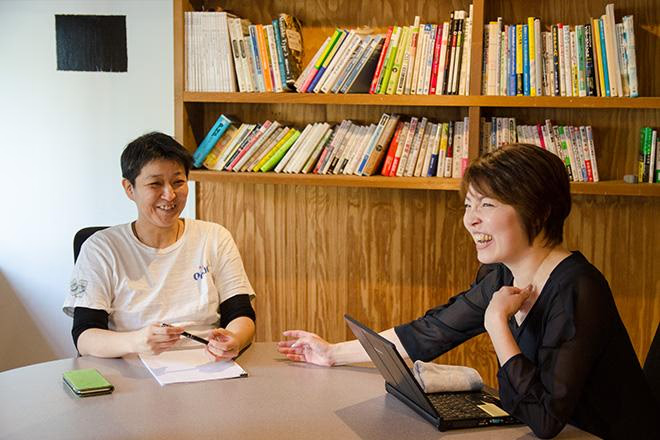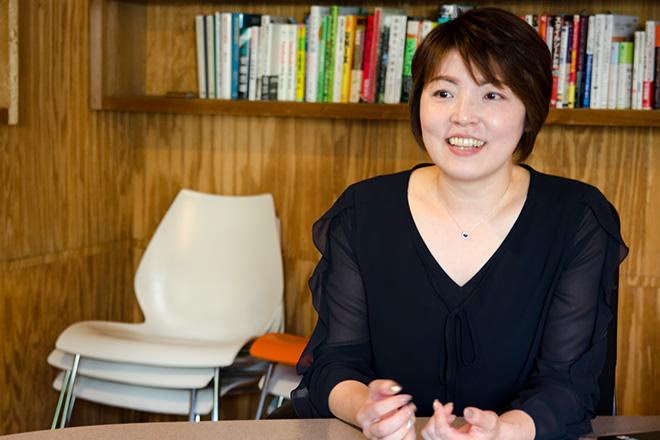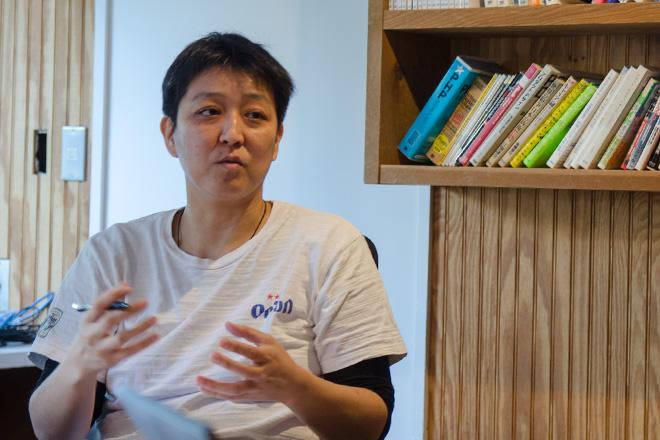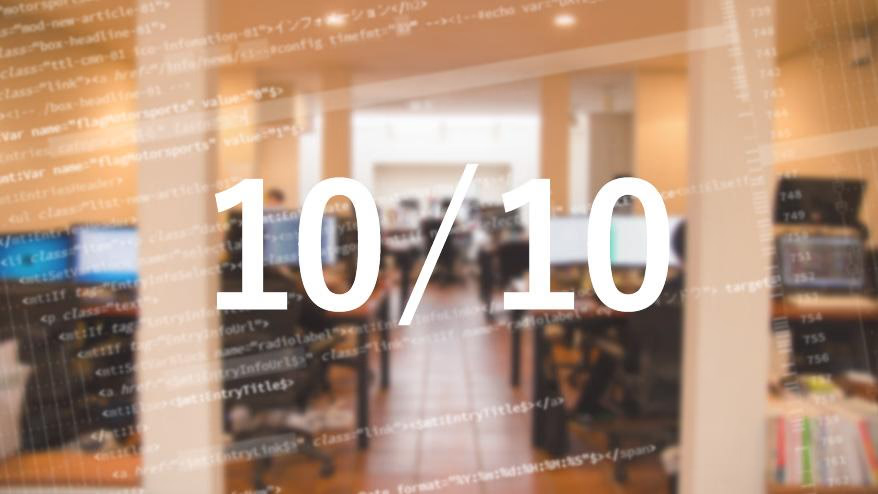コーディングファクトリーにとって、2017年は、サービス開始から10周年、納品ページ数が10万ページ突破と、「10」の並ぶ節目の年となりました。
ところが、先月達成した10万ページを突破時、社内の盛り上がりはいまひとつでした。かつて1万ページ突破を達成した時は社内でパーティをして、祝うくらい盛り上がったにもかかわらず……。
「1万ページの時と明らかに熱量の差がある」
この事実は、Web制作を取り巻く環境の変化と、コーディングファクトリーに求められる役割が変化してきていることを象徴的に表していると感じます。そこで、制作責任者であるコーディングファクトリー部部長 児嶋と、営業の責任者、セールス部部長の奥山が「これまでのCFとこれからのCF」について対談しました。

コーディングファクトリー部部長 児嶋(左)とセールス部奥山
作ったページ数がコーディングの価値だった…。
大型案件、制作範囲の複雑化、
変わりつつあるコーダーの役割。
-
 児嶋
児嶋 -
私が入社する前の話だから、よく知らないんだけど、コーディングファクトリー(以下、CF)は、サービスを始めた当初から制作したページ数と案件数をカウントして、CFニュースやWebサイトで公表してきたんでしょう。でも、そもそもページ数や案件数を公開してきたのはどうしてだったの?
-
 奥山
奥山 -
CFは黒子の立場で仕事をすることが多いから、関わった案件そのものを「こんなサイトをやりました!」と公開はできなかったのが理由の1つ。でも、お客さんの安心感は得ていきたい。そう考えたとき、量的な指標としてページ数と案件数を公開することがいい方法かなと思ったのが、最初のきっかけだったと思います。
実際、数字のカウントを継続する中で、増えていくページ数と案件数が、自分たちの仕事の実績を表す重要な数字になっていったんだよね。CFのサイトを見ると、2009年5月に1万ページを達成しているんだけど、そのときは課内で歓声が上がったし、CF立ち上げから1年6ヶ月の道のりを祝って、みんなでパーティもした。でも、先月新たな節目になる10万ページを達成したけど、いまいち盛り上がらないんですよね…。
-
 児嶋
児嶋 -
確かに。いまいち盛り上がっていないよね。その理由は、Webの作り方が変わって、コーダーにとってページ数や案件数というモノサシが、実績を表すものじゃないというか、少しズレてきてるんだと思います。 例えば、「CMSを駆使したテンプレート構築はページカウントができない。」「JSを駆使して制作するパララックスのページカウントはどうなるのか?」とか。実績として表される数字(ページ数)と実際にかかった工数・技術力(成果)の感覚がズレてきているんだと思うんだよね。
-
 奥山
奥山 -
CMSは元々CFのサービスとしてあったんだけど、メインはあくまでもコーディングだった。それがここ数年、コーディングに伴うCMS、JS実装といった枠から外れるような上流のご相談にも対応できるようになっていったんですね。 お客様との関係性構築ができ、関わる範囲も広がっていく中で、単価も上がっていって。その流れの中で、リピートのお客様の方がお互いの状況もわかっているし、理解しあって、それぞれの足りないところを補完しましょうというような営業もできるようになったんですね。
私たちとしても1案件、1プロジェクトを一緒に協力し合ってやろうと望んでくれるお客様とは、うまくいく。単なる外注先として「うちが仕事を依頼しているんだからさ」という関係性じゃないお客様がリピートしてくださる傾向があります。

-
 児嶋
児嶋 -
制作チームとしては、やっぱり相談しながら作っていくのが一番向いていると感じているかな。昔は入稿セットがあって、お客様にきちんとあらかじめデータを全部用意してもらわないとできませんみたいな状況があったと思うんですよ。 でも、お客様もコーディング前に入稿セットをきちんと用意できなくて、現場がバタバタしていた。当時は、セットがないとできないメンバーも多くて、お客様も出しきれない状態があって…。うまくいかないピークがあったと思うんです。
変わり始めたのは大規模案件が平行して走るようになってから。大規模の場合、その都度、その都度、お客様と抜け漏れについてやりとりしていくのが当たり前だから、その過程で制作が安定していった実感があるかな。 そこから“お客様とやりとりしながら期限内にできればいいね”と考えられる感じに育ってくれたので。大変な時期のピークが2013年くらいで、この3年で自然発生的にお客様とコミュニケーションを取りながら制作するやり方が浸透した感じ。その方がうまくいくということをコーダーたちがよくわかってくれたのが大きいと思う。
-
 奥山
奥山 -
お客様の側もWeb制作の変化を敏感に感じ取っていて、この数年、担当コーダーがお客様と直接やりとりをするという進めかたが大きな売りになっています。専門家であるコーダーと直接話をして、案件を進められるので、スムーズだし、結果として品質も上がると。
コーディング全体の仕様設計、レスポンシブ設計、CMS構築、難易度が高めのJSなど、コーダーとコミュニケーションを取れることでサイト自体の品質があがります。また、ページ数が多い案件では、お客様が指示書をすべて用意できなくても、コーダーが質問を投げかけ、形にするような作りかたも可能になりました。
時間がないからこそ、アウトソーシングしているというお客様の本音に寄り添い、お客様の方で仕様書が用意できない状況があったとしても、妥当なクオリティで納期に間に合わせられる制作ができるようになったというか、本来必要な工数が圧縮できるようになってきたんです。そういう専門家とのコミュニケーションに価値を感じてくれるお客さんが多くなっている気がしますね。
アジャイル開発とウォーターフォール型の
ハイブリットな制作体制へ
-
 児嶋
児嶋 -
制作側としても、今のWebは直接やりとりをしないと作りにくくなっています。
例えば、従来のウォーターフォール型の開発でお客さんから入稿されるデザインを見ただけだと、「ここはどういう動きをするんですか?」といった疑問が残るわけです。検索窓があったとして、「どういう検索の仕様になっているんですか?」、CMSを入れるにしても「何件表示したらいいんですか?」、「SNSのボタンを押したら何が開くようにしたらいいですか?」と。デザインの段階で仕様を細かく決めきれなくなった部分がたくさんあります。そこで、デザインになる前に、コーダーがお客さんと話をしながら、モックを作って操作感を試してもらいながら調整しつつ仕様を詰めていく、アジャイル開発っぽいやり方が増えています。こちらから手を伸ばし、無数にある正解の間で揺れるお客さんの話を聞き、相談に乗り、できることできないことを整理して、適した落とし所を提案する。Webの作り方が複雑になった中で、自然とそういう関わり方になっています。お客さんも「CFにはこんなことを求めていいんだ」と変化してきた面もありますね。

-
 奥山
奥山 -
たしかに、数年前までは一プロジェクトのコーディングというテクニカルな領域だけを渡され、納品するという関係でしたけど、その関係感、距離感は変わってきましたよね。より深くプロジェクトの中に入り込んでいる印象です。お客様の中にはディレクターさんメインの会社もあるので、テクニカルな領域を自社では賄い切れない。デザイナーさんがデザインするとき、“こういうデザインにして、こんな動きをさせたい”と想像するけど、実際に“コーディングはできるのかな? やれるかな?”というのがわからないこともあります。
そこで、「このデザインを実現させるためには、この動きが必要です。だけど、そもそもそれはできるのか、コーダーさんに聞いてみたい。でも、社内にいない」「企画、設計はやるけども、コーディング作業やフロントエンドのところはプロに任せたい」と。そんな会社さんも増え、分業化が当たり前になってきています。
-
 児嶋
児嶋 -
私たちは裏側のソースコードを知っているから、「こうしたらこうなりますよ」「こうしたらこういうこともできますよ」とできることの選択肢を提示して、お客様に決めてもらうことができます。制作側としては、限られた予算と工期の中である程度のものをつくり上げるために、お客様がどの手を欲しているのか、いくつかの手を伸ばして、あとは選んでもらうだけにしていきたい。そのためにも、もっとお客様のところへ入っていき、ともに作り、相談に乗っていきたいですね。
現実として、仕様が来るのをを待っていてもいつまでもこないこともありますし、来ても揺れることもありますし、決まらないこともあります。そうなると、スケジュールを抑えていても、その通り行かないので。コーダーたちの稼働を安定させるためにも、私たちが前に出て「ここだよ」という道筋を見せて、仕様をどんどん確定させていかなくちゃいけない。
そういう「案件を着地させるための手段をいっぱい提案すること」が重要で、意外と作ったページ数ってどうでもいいのかなと思っちゃったところもあるかな。期間とリソースが限られている中、お客さんと丁寧にコミュニケーションを取りながら、着地すべきラインを見つけ、形にしていく。そういう質の部分を大切にする方が、お客さんも求めていると思います。
「一緒に」つくる、考える
ひとつのことを共に乗り越える戦友として
-
 奥山
奥山 -
できるんだ、やってくれるんだとわかった結果だと思うんですけど、この2年でCFのリピート率が急増しています。一昔前までは新規のお客さんが圧倒的に多かったんですが、昨年もリピートのお客さんが新規を大幅に上回っています。
これはプロジェクトを一緒に協力してやろうと臨んでくれるお客さんが増えたこと。プロジェクトの中に私たちがより深く入り込んでいて、「外注先」から「パートナー」という関わり方に変わってきたことの現れだと思います。
感触としては、うまくいった案件よりも、山あり谷ありでやっと納品、やっと公開だよという案件ほど、お客様に感謝されている印象もあります。制作している期間はお客様にも不安があるけど、案件が終わったら感謝してくださる。危機的状況を一緒に乗り越えた人たちと次また、みたいな。そこには何かが生まれているんだと思うんですけど。
-
 児嶋
児嶋 -
すでに、いくつかの案件で実感したことだけど、作っている間にパートナーになれるような仕事のやり方をしていきたいですね。 「発注会社の担当者の名前だけは知っている」という関係ではなく、ミーティングを繰り返すうち、お客さんがCFのメンバーのことを親しみを持って愛称で呼んでくれるような関係になれることもあります。
私は「戦友感がある」と言っているんですけど、厳しい案件の中で一定のクオリティを保ち、納期を守ることで生まれる信頼感。それをベースに、より広く深く関わりあっていける関係を作っていきたいですね。
-
 奥山
奥山 -
CFに求められる領域がコーディングからフロントエンドへと変化したように、CFを軸にしながらモノサスという一企業としてお客さんに関われるようになりたいですね。モノサスにはコーディングだけじゃなく、デザインや運用等、いろんなチームがありますからね。それは私がセールスになったときから「こうなりたい!」とイメージしていたことです。それが今、叶うところまで来たのかなと感じています。
-
 児嶋
児嶋 -
今まではCF単独の仕事が多かったのですが、要件定義やワイヤーを書くなどの上流のところを担える人、デザインチームなど、他部署と連携して、「モノサス」として案件を消化できる仕組みができつつあるかな、と。そういう仕事がどんどん増えていったらいいなと思うし、そのための窓口としてCFが機能するのもいいなと思ったりもします。
-
 奥山
奥山 -
コーディングから領域がフロントエンドになったように、CF部も他部署と協力し合いながら、モノサスという一企業としてお客様に関われるような、そんな企業になってきた気がするよね。
-
 児嶋
児嶋 -
今、まさにお客さんと一緒に仕様を決めたり、UIを一緒につめていくようなアジャイル開発とウォーターフォール型の合わせ技みたいな制作体制に取り組んでいるし。これはCFにとって初めてのことで、今後の展開が本当に楽しみです。
-
 奥山
奥山 -
そういう案件がもっと増えたら、仕事をするのがもっと楽しいと思えるはずだから、これからのCF・モノサスの変化に期待が膨らんでいます。

